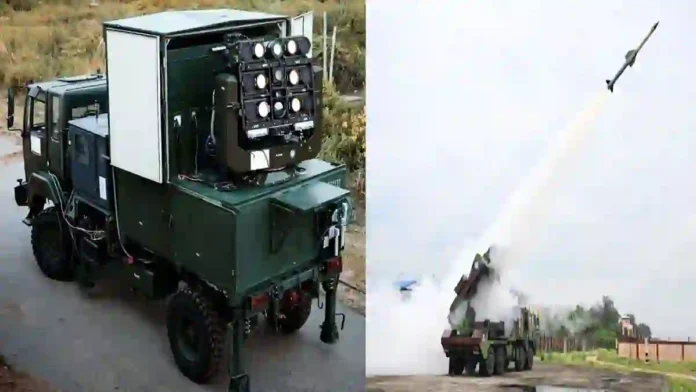India’s advanced Integrated Air Defence Weapon System (IADWS) represents a significant leap in indigenous defence capability, delivering a robust, multi-layered shield against diverse aerial threats such as enemy aircraft, drones, missiles, and loitering munitions.
The system is a synthesis of advanced technological innovations, integrating three key components—Quick Reaction Surface-to-Air Missiles (QRSAM), Very Short Range Air Defence System (VSHORADS), and a high-power laser-based Directed Energy Weapon (DEW)—under a unified, network-centric architecture.
Read- Sukhoi Su-57 Stealth Fighters To Be Made In India?
IADWS functions as a multi-layered, network-centric shield designed to protect critical military and civilian assets from a wide spectrum of aerial threats, including fighter jets, helicopters, cruise missiles, unmanned aerial vehicles (UAVs), loitering munitions, and drone swarms.
Centralised Command And Control
At the heart of the IADWS is the Centralised Command and Control Centre (C2C2), which unifies data streams from various radars and electro-optical sensors to generate a comprehensive real-time air picture of the area under defence.
This centre automates threat evaluation by assessing factors like velocity, altitude, radar cross-section, and flight path, rapidly allocating each threat to the most suitable defensive layer or effector. The advanced C2C2 architecture provides seamless connectivity between sensors and shooters—and is built for “man-on-the-loop” operation, where automation allows human controllers to supervise rather than manually operate every step.
Layered Interception Architecture
The multi-layered composition of a modern IADWS ensures redundancy and resilience: each layer is specialised for engaging threats at distinct ranges and altitudes.
Outer Layer: Quick Reaction Surface-to-Air Missile (QRSAM) Systems
These systems are equipped on high-mobility launchers and use active radar homing to engage fast-moving aerial threats such as fighter aircraft, helicopters, and stand-off precision weapons like cruise missiles at interception ranges of approximately 25-30 km and altitudes up to 10 km. QRSAM units possess “search on move” and “track on move” capabilities, ensuring real-time detection and rapid response during mobile operations.
Read- Rajnath Singh Announces Progress On Indigenous Powerful Jet Engine
Middle Layer: Very Short Range Air Defence (VSHORADS) Systems
VSHORADS represents the last line of defence against low-flying threats, including UAVs, helicopters, and slow-moving aircraft. These MANPAD (man-portable air defence) units use advanced imaging infrared seekers and are effective up to around 6 km range and 4 km altitude. Their lightweight and versatile deployment allow coverage of tactical units across army, navy, and air force environments.
Innermost Layer: Directed Energy Weapons (DEW)
The most recent advancement is the inclusion of high-powered laser-based DEWs, specifically developed to counter UAVs and loitering munitions at close proximity. DEWs offer virtually unlimited firing capacity, emitting concentrated energy bursts to damage airframes and disable electronics, making them highly cost-effective for sustained engagements against swarming drones.
Sensor Networks And Data Integration
Multiple sensor types—such as long-range surveillance radars, engagement radars, infrared sensors, and electro-optical systems—are networked together. These sensors provide real-time detection and identification of airborne threats, with advanced systems capable of correlating data from several tracks to differentiate between multiple entities or hostile formations. The integration of satellite data for high-altitude detection further extends coverage.
Read- Modi says Russia and India stand together even in difficult times
Battle Management And Weapons Control
The system transitions from surveillance to battle management upon threat identification. This involves evaluating threats, deciding on engagement, selecting the appropriate weapon, and authorizing the interception. When a threat track is confirmed, the command centre triggers weapons pairing: acquisition, tracking and guidance of the interceptor toward the target. Feedback and continuous monitoring ensure precision engagement.
Communications And Networking
Modern IADWS employ robust, multi-channel communications utilizing fibre optics, landlines, radio, and electromagnetic spectrum links, ensuring real-time data-sharing, rapid coordination, and resiliency against electronic warfare or cyberattacks. This distributed architecture allows sub-systems to operate independently or as part of a larger network, maximizing overall defensive coverage.
By integrating kinetic interceptors and non-kinetic directed energy weapons under an automated command centre, the IADWS ensures that if one layer fails or is overwhelmed, other layers can immediately respond, providing uninterrupted protection. The layered defence design also optimizes cost, speed, and operational simplicity by pairing the right weapon for each threat type and trajectory.
Conclusion
A modern Integrated Air Defence Weapon System is a sophisticated, automated, and highly redundant network, combining advanced radars, highly mobile missile systems, man-portable air defence, and cutting-edge directed energy weapons. It protects strategic locations from diverse and increasingly complex aerial threats by employing layered interception, robust communications, and centralized battle management, synchronized under a unified, real-time operational architecture.
IDN (With Agency Inputs)
Agency




